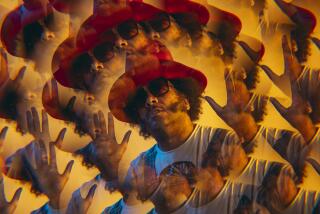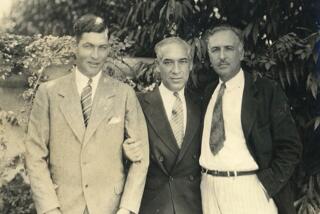Joseph M. Wilcots dies at 70; cinematographer on ‘Roots’ and its sequel
- Share via
Joseph M. Wilcots, a trailblazing African American cinematographer whose credits include the landmark 1970s TV miniseries “Roots” and “Roots: The Next Generations,” has died. He was 70.
FOR THE RECORD:
Wilcots obituary: The obituary of cinematographer Joseph M. Wilcots did not include two of his sisters in the list of survivors. They are Imogene Henry and Angeline Lucas. —
Wilcots died Dec. 30 at Antelope Valley Hospital in Lancaster of complications from a stroke he suffered in 2008, said his manager, Phyllis Larrymore Kelly.
The first African American to join the International Cinematographers Guild -- in 1967 -- Wilcots initially worked on camera crews for TV series such as “The F.B.I.” and “Mission: Impossible” and on films such as “The Learning Tree,” “The Last Picture Show,” “The Cowboys” and “Lady Sings the Blues.”
As a director of photography, he achieved his greatest acclaim for “Roots,” the 1977 ratings phenomenon based on Alex Haley’s bestselling epic family saga.
“Joseph Wilcots could be considered the Jackie Robinson of cinematography,” Steven Poster, president of the International Cinematographers Guild, Local 600, said in a statement.
Describing Wilcots as “a kind and gentle man with amazing talent,” Poster said Wilcots “loved the work he did and gained the respect he deserved throughout the industry.”
In 1977, Wilcots received a national Emmy nomination for “outstanding cinematography in entertainment programming for a series” for Part Seven of “Roots.” His work on “Roots” also earned him a local Emmy nomination.
“In doing a picture called ‘Roots,’ we felt it important that we should have an African American cinematographer,” “Roots” executive producer David L. Wolper told The Times this week.
“It’s extremely difficult to photograph African Americans,” Wolper said, “because when you shoot a scene with an African American and a white person standing next to each other, the lighting is so complex, and he was an expert in that.”
Louis Gossett Jr., who played Fiddler in “Roots,” agreed.
“As the cinematographer, Joe said, ‘This is going to take some time if this is going to look good,’ ” said Gossett. “It was a challenge for him to balance in the same scene those colors and the different gradations of skin.”
As for the result, Gossett said, “We all loved it. It had to be very difficult for that man with that time frame and time pressure, but he did it.”
Said LeVar Burton, who played Kunta Kinte, the African who is abducted, taken to America via slave ship and sold to a Virginia planter in the 1700s: “What stands out immediately is that the look and feel of ‘Roots’ holds up today, in 2010; it does not feel dated at all.”
Burton said Stevan Larner was the director of photography on the first three hours of “Roots.”
“Joe started in hour four and took it the rest of the way,” he said. “What I remember about Joe on that shoot is that he’s a very gentle, gentle soul, as well as a very talented man.”
For Burton, the “compassion of the man” was evident while shooting the final scene in hour four in which Kunta Kinte is whipped and forced to take the name Toby.
“For me, the challenge was standing still while this guy with a whip was letting it go behind me at 120 miles an hour,” recalled Burton. “We rehearsed it, Joe lit it, they gathered all the extras, [but] it wasn’t working. I was way too skittish.
“He and the director, John Ermin, recognized this was a very important scene, and I needed to get comfortable with my back to the whip. Joe was very supportive, [saying], ‘Let’s go to something else; let’s put this back on the schedule for another day.’ ”
In the early part of “Roots” when he was shooting Burton, Wilcots said in a 2007 interview with the Archive of American Television, “I wanted to make the audience smell the dirt and to create such an atmosphere that the dirt was the second part of the picture.
“And I was able to accomplish that by whenever I had the opportunity I would either start on the dirt or shoot something of dirt around and so there was like a hidden meaning, and it was the dirt and the earth.”
Among Wilcots’ other credits as a cinematographerare “ Bill Cosby: Himself,” “Where the Red Fern Grows: Part 2” and the TV series “Matlock,” “Palmerstown, U.S.A.” and “Brewster Place.”
For 15 years, he also worked variously as a cinematographer, photographer, producer, director and editor on Michael Jackson’s music videos, tours and other projects.
Wilcots was born Feb. 1, 1939, in Des Moines.
After a four-year stint in the Navy as a photographer, he worked four and a half years at Westheimer Co., a Hollywood optical house for which he was involved in providing visual effects for “Star Trek” and other TV series and commercials.
Wilcots is survived by his wife Annette; his son, Joseph Wilcots II; his daughter, London Morrow Wilcots; his sisters, Loretta Hall, Virgie Monroe and Lois Newcomb; and his brothers, Michael and Henry Wilcots.
A celebration of Wilcots’ life is pending.
More to Read
Start your day right
Sign up for Essential California for the L.A. Times biggest news, features and recommendations in your inbox six days a week.
You may occasionally receive promotional content from the Los Angeles Times.






